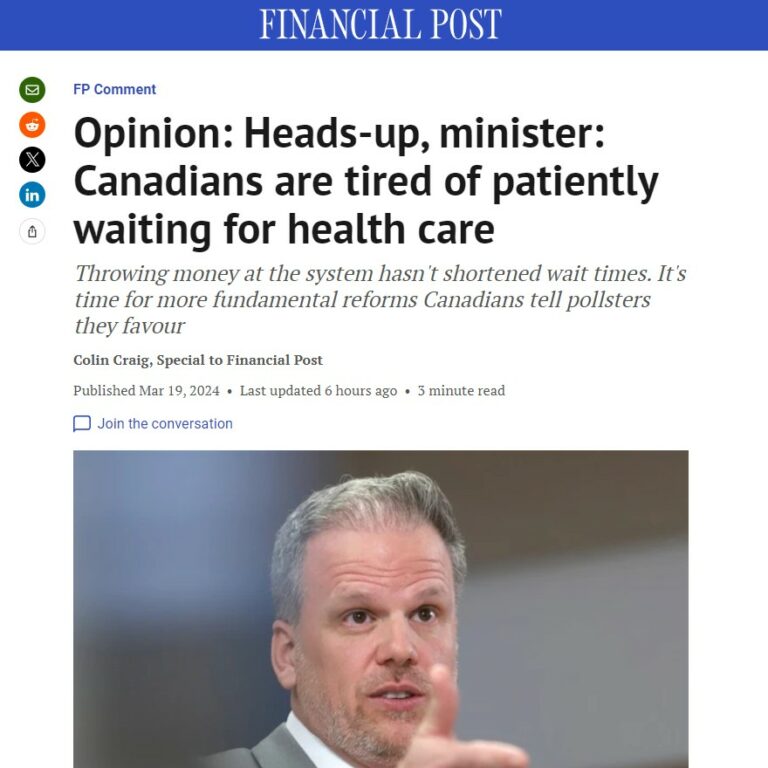FINANCIAL POST COLUMN: Heads-up, minister: Canadians are tired of patiently waiting for health care

Federal Health Minister Mark Holland thinks Canadian patients need to be more patient when it comes to health services. Respectfully, minister, time is up. For over 30 years, Canadians have watched political parties of all stripes throw money at the health care system and hope for the best. The results speak for themselves. What Canadians desperately need now is not more patience but health reform.
In his recent press conference, Minister Holland advised Canadians: “I would say to folks, most of the waiting that is occurring is for elective procedures or for procedures that are not an emergency circumstance. That people be patient with those.”
In 1993, according to the Canadian Institute for Health Information, our governments spent $1,688 per person on health care. Last year, spending reached $5,748 per person. That increase is nearly double the rate of inflation. Yet over this same period, Fraser Institute research shows, wait times increased from nine weeks to nearly 28 weeks.
More money, longer wait times. The “throw more money at the system” approach has clearly failed.
Government data show that over 17,000 patients died last year while waiting for surgery or a diagnostic scan. That’s roughly an NHL-sized arena full of patients. The number would be larger except that several health bodies, including most of Quebec’s, simply don’t track this important information. Many of these patients would have spent their final days with cloudy vision or in chronic pain while waiting for cataract surgery or hip operations. For Canada to allow this to happen is simply inhumane.
But the data also show cases where patients died because the government simply took too long to provide surgery. Ontario government data show that since 2013 more than 931 patients have died while waiting for heart surgery — 244 of them after having waited longer than the recommended maximum wait time.
SecondStreet.org spoke with retired nurse Judy Anderson, who shared how she has lost not one but two daughters due to long wait times. Both had treatable heart conditions but were made to wait too long.
During his press conference, Minister Holland suggested Canada has one of the best health care systems in the world, citing an unnamed source that ranked Canada’s system “second best” globally. The minister might want to run that claim by the 85 per cent of Canadians who told Ipsos health care needs “drastic” changes.
Perhaps Holland’s sharpest critique was for the idea of Canadians being allowed to choose between the public system private options — which 63 per cent of us think we should be able to do, according to another recent Ipsos poll. (It was in keeping with a Leger poll commissioned by SecondStreet.org in late 2022 that found 62 per cent favour having private options.)
Minister Holland claims that countries that have systems that allow private options have ended as an “abject failure.” Funny, the rest of the world doesn’t share that view. Sweden, Norway, France, the United Kingdom, Australia, New Zealand — all these countries give patients a choice between using their universal public health care systems or paying for private options. They also score consistently higher in the Commonwealth Fund’s international health care reports than we do.
In fact, no other developed nation has the nonsensical bans on private care that Canada does. Currently, it’s OK for a Calgarian to pay for surgery in Vancouver but not in Calgary and vice versa. These local bans on private payment for medically necessary health services occur everywhere except in Quebec. Why inconvenience patients and increase their costs? Only an ideologue would think this makes sense.
Ultimately, what Canada needs is a system that puts patients — not interest groups and partisans — first. Just as the rest of the developed world has done, Canada needs a more collaborative approach with private health providers, not the demonization we’ve seen from many politicians for the past 30 years.
At the federal level, a good first step would be for Minister Holland to stop spreading misinformation by learning more about what has actually been working well beyond our borders. Patients are tired of being patient.
You can help us continue to research and tell stories about this issue by making a donation or sharing this content with your friends. Be sure to sign up for our updates too!


